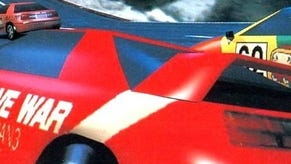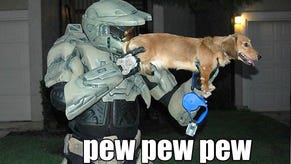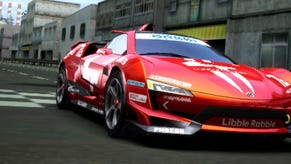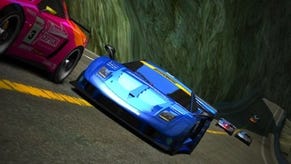Ridge Racer retrospective
Youuuuuuuuu're the greatest!
Back in the spring of 1994, there were plenty of astonishing things to catch your eye at the Trocadero. Galaxian3 showed the glorious peak of Laserdisc games. There was a Virtua Racing multiplayer cab that had cockpit cameras showing the players' faces. There was the sprawling 8-player Daytona USA (which would sit in place until the Trocadero's bitter end), a silky smooth racer complete with a 3D Sonic carved into a cliff face. But all this was nothing compared to what sat at the top of the escalator: a full-size Mazda Eunos Roadster in front of a giant screen, which was showing the most astonishing video game graphics I had ever seen. As an excitable man shouted the game's name, a red car flung itself around a coastal metropolis rendered in fully texture-mapped 3D graphics, all at a beautifully smooth frame-rate. I stood agape, knowing I was witnessing the future.
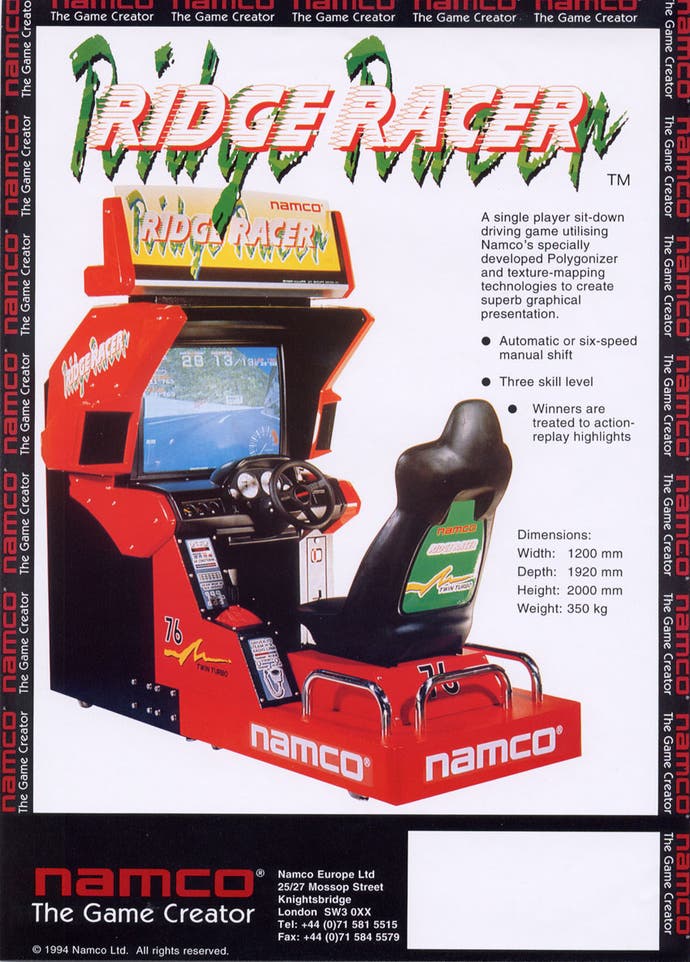
Ridge Racer was Namco's second stab at a 3D racing game series. 1988's Winning Run marked a new dawn in realtime polygons, gunning for a flat-shaded Formula 1 simulation some four years before Virtua Racing. Four years before that, Atari's hilariously rare I, Robot launched as the first polygon-shunting arcade machine. It was so ahead of its time that if you'd told people about playing it, they'd think you were lying. At that time, Star Wars' wireframes were more than enough to fry your brain, and I, Robot is fringe exotica in the gaming mainstream; an astonishing early pioneer of polygonal 3D, but proof of technology in search of "proper" application. With Winning Run, Namco had delivered 3D as proof of concept. The proof was that racing games were a fine application for realtime polygons. Ridge Racer was 3D as proof of supremacy. With it, sprite scaling was dead. Flat shading was dead. Hard Drivin', Indianapolis 500 and Geoff Crammond's F1 Grand Prix had suddenly become rudimentary. The future would be Gouraud shaded and texture mapped, and the arcade was still king.
When Sony announced that its mystical new console would launch with Ridge Racer as a flagship title, the arcade came home for a second time. We'd waited five or six years between 16-bit arcades and 16-bit consoles, but Ridge Racer took just a year to bring the cutting edge of the arcade into our houses. We didn't know that this time it was to stay, but we should have realised that a console built specifically to deliver realtime 3D polygons would be truly revolutionary. With Ridge Racer leading the charge, it finally became a game to master. And what a tight little gem it was! So tight, in fact, the entire game famously fitted into the PlayStation's meagre 4MB RAM, allowing the trick of popping the CD out and racing to your own soundtrack. It's a shame that this is (pretty much) the sole thing people recall about Ridge Racer now. As a game, it's actually a thrilling and wonderfully unfussy delight.
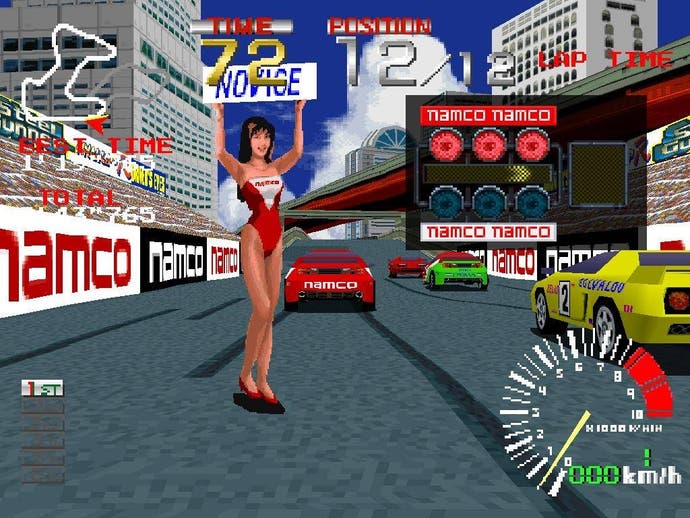
One of the outstanding things about Ridge Racer is its single track. It's burnt into my synapses, meaning that many years after I stopped playing it regularly, I still remember all the drift points. I still remember all the landmarks. Not just the screen showing Galaxian on the first lap, but the tunnel with traffic visible on other lanes, then the suspension bridge and the tricky double apex right-hander after it (drive the first, drift the second), then the palm trees along the beach, the big rocky right-hander the announcer warns you about, and the left that leads to the helicopter at the jump. Then another tunnel and the straight to the last right-hander or the sharp left that leads to the tortuous extension for the hard and TT modes. There are the billboards proudly displaying a roll-call of Namco's arcade history. And there's those orange-lit tunnels, harking back to bitmap progenitors in Chase HQ and Super Monaco GP.
Booting up the PlayStation version in 2014, it only takes a lap before I'm diving at the corner entries to nail Ridge Racer's dark arts: the rev-boosting elite drifts. I know the skinny ribbon where the elite drift lies is perilously close to the wall, and it's remarkably exciting and satisfying to pull it off. The announcer declares it was a great "cowner", and that I have to teach him. Of course, Ridge Racer's drifting is hilariously overblown, but the elite drift is the master's domain. It's one thing to have binary powersliding (often a critique of the entire series), but another entirely to find the tightrope that pops you out of the corner with extra speed. Nailing every one of these is what you need to beat the Angel car, the sinister monster that lurks on the TT track once you've beaten everything, taunting you with a vast head start before shooting up your polygonal backside with shocking pace. I never did manage to beat that bastard, but my friend did. He still ranks it as one of the most exhilarating and exhausting achievements in all his gaming life.
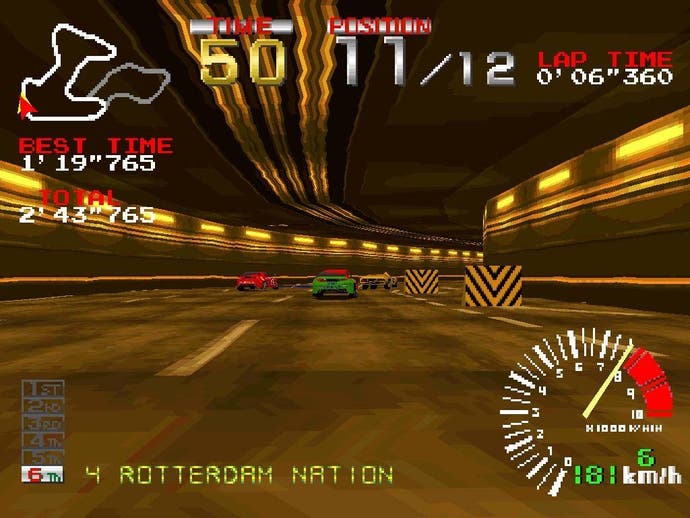
In many ways, Ridge Racer marks a landmark from an era of astonishing transition, and it's as emblematic of the arrival of real-time 3D as the Virtua series. While there were technically impressive predecessors (notably Hard Drivin'), Ridge Racer stands alone as an explosive superstar of the biggest generational shift in gaming technology we've ever seen, delivering its bravura technical achievement with fun and madness (but no mooing cow, sadly). Ridge Racer is one of very, very few games that straddled arcade and console while maintaining the same shock and awe. It remains deliciously compact and taut when its sequels have become either bloated or strangely pedestrian, despite vast increases in car counts and, on reflection, slightly dubious boost mechanics. I'd forgotten how sweet the elite drift mechanic was until I uncovered it again, and can't help but feel that the nitrous boosts of later games are a poor relation, offering much less of a balance between risk and reward while adding a lot of extra speed for a lot less skill.
Going back to the original Ridge Racer makes me want to start afresh in Rage Racer or Type 4, pick up my long-neglected threads in Ridge Racer 7 and get the PSP version installed on my Vita. We often forget how tied to PlayStation the entire series is, and it's saddening that the PlayStation 4 doesn't have a Ridge Racer to call its own. The last entry wasn't really part of the series, so maybe it's time to demand a stupendously glossy HD rebuild of the PlayStation original. Maybe then I'll be able to take to my beloved yellow Solvalu and take on the Angel car showdown for once and for all. While fastidious sims such as Forza and Gran Turismo offer tantalising steps towards reality, I can't help but miss the glee of recklessly chucking a car into a drift to the sound of Rotterdam Nation, Feeling Over and Rare Hero. At the time it was thoroughly modern music for a thoroughly modern game, and even though it was frivolous dressing around a terribly portentous future, it was all just so much unabashed fun. Burnout can get stuffed. There's no room for ghoulish carnage in Ridge Racer. There's just the track, the drifts and the pure joy of combining the two.


.png?width=291&height=164&fit=crop&quality=80&format=jpg&auto=webp)

